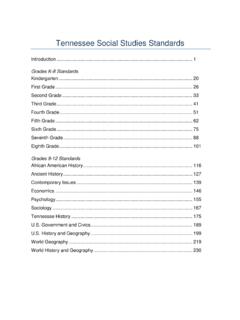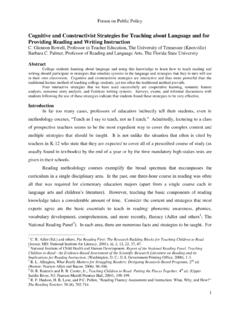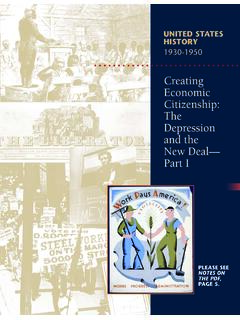Transcription of Sexual Objectification © The Authors 2011 of Women ...
1 The Counseling Psychologist39(1) 6 38 The Authors 2011 Reprints and : of Tennessee, Knoxville, TN, USAC orresponding Author:Dawn M. Szymanski, Department of Psychology, University of Tennessee, Knoxville, TN 37996-0900, USA Email: Objectification of Women : Advances to Theory and ResearchDawn M. Szymanski,1 Lauren B. Moffitt,1and Erika R. Carr1 AbstractObjectification theory provides an important framework for understanding, researching, and intervening to improve Women s lives in a sociocultural context that sexually objectifies the female body and equates a woman s worth with her body s appearance and Sexual functions. The purpose of this Major Contribution is to advance theory, research, practice, and training related to the Sexual Objectification of Women . The purpose of this article is to introduce readers to Objectification theory and related research, extend Objectification theory to our understanding of Women s substance use and/or abuse and immersed forms of Sexual Objectification via sexually objectifying environments, and provide an overview of this Major Contribution on Sexual Objectification of Objectification , Sexual assault, self- Objectification , feminism, substance abuseObjectification theory (Fredrickson & Roberts, 1997) provides a framework for understanding the experience of being female in a sociocultural context that sexually objectifies the female body.
2 Objectification theory has become an Major Section on Sexual Objectification of WomenThe Division 17 logo denotes that this article is designated as a CEC article. To purchase the CE Quiz, please visit et al. 7important organizing perspective for a great deal of research within feminist and counseling psychology and fits well within the multicultural-feminist and social justice missions of counseling psychology. These missions encourage psychologists to understand the ways that contextual factors, such as Sexual Objectification (SO), impact Women s lives and the problems that they bring to therapy, as well as how they manage, cope with, and resist these SO expe-riences (American Psychological Association [APA], 2007a). In addition, they encourage psychologists to examine issues of diversity and oppression under patriarchy at micro- social ( , interpersonal) and macro- social levels ( , environmental and institutional levels) and to advocate for social justice for exploited Women and communities (Speight & Vera, 2004).
3 The purpose of this Major Contribution is to build on Objectification theory and Moradi and Huang s (2008) recent review of the empirical research by advancing theory, research, practice, and training related to the SO of Major Contribution on Sexual Objectification consists of four articles. In this first article, we provide an overview of Objectification theory and related research. Next, we extend Objectification theory by demonstrating how it might be useful in understanding Women s substance use and/or abuse and recogniz-ing immersed forms of SO via sexually objectifying environments. The second article (Carr & Szymanski, 2011 [this issue]) presents the results of a quantita-tive study examining some of our theorized relations between SO and Women s substance abuse, whereas the third article (Moffitt & Szymanski, 2011 [this issue]) presents the results of a qualitative study exploring in depth the experi-ences and coping strategies of Women who work in sexually objectifying envi-ronments.
4 Finally, given the widespread prevalence of the SO of Women in culture, and the documented potential negative effects it can have on females, it is important that psychologists know how to integrate this informa-tion in their work with Women and in their training of future psychologists. Given counseling psychology s social justice mission, psychologists also need to be know how they can engage in social justice advocacy aimed at challeng-ing and eradicating the SO of Women at individual, interpersonal, organiza-tional, institutional, policy, and sociocultural levels (APA, 2007a; Speight & Vera, 2004). Thus, the fourth article (Szymanski, Carr, & Moffitt, 2011 [this issue]) provides clinical suggestions for psychologists working with clients on issues related to SO and implications for psychologist Objectification TheoryObjectification theory (Fredrickson & Roberts, 1997) postulates that many Women are sexually objectified and treated as an object to be valued for its use 8 The Counseling Psychologist 39(1)by others.
5 SO occurs when a woman s body or body parts are singled out and separated from her as a person and she is viewed primarily as a physical object of male Sexual desire (Bartky, 1990). Objectification theory posits that SO of females is likely to contribute to mental health problems that disproportionately affect Women ( , eating disorders, depression, and Sexual dysfunction) via two main paths. The first path is direct and overt and involves SO experiences. The second path is indirect and subtle and involves Women s internalization of SO experiences or self- Objectification (Fredrickson & Roberts, 1997).Fredrickson and Roberts (1997) asserted that Women to varying degrees internalize this outsider view and begin to self-objectify by treating them-selves as an object to be looked at and evaluated on the basis of appearance. Self- Objectification manifests in a greater emphasis placed on one s appear-ance attributes (rather than competence-based attributes) and in how frequently a woman watches her appearance and experiences her body according to how it looks (McKinley & Hyde, 1996; Noll & Fredrickson, 1998).
6 Objectification theory also posits a mediation model that may explain how self- Objectification leads to Women s mental health risks via negative psychological outcomes. More specifically, Fredrickson and Roberts (1997) postulated that self- Objectification can increase Women s anxiety about physical appearance ( , fear about when and how one s body will be looked at and evaluated); reduce opportunities for peak motivational states or flow; diminish awareness of internal bodily sensations ( , hunger, Sexual arousal, stomach contractions); increase Women s opportunities for body shame ( , the emotion that results from measuring oneself against a cultural standard and coming up short); and increase Women s anxiety about their physical safety ( , fears about being raped), which in turn can lead to disordered eating, depression, and Sexual dysfunction (see Figure 1).Research examining Women s internalization of SO via self- Objectification has flourished and supported many of the theoretical tenets of Objectification theory (for a thorough and critical review, see Moradi & Huang, 2008).
7 However, research focusing on external SO experiences and their theorized negative outcomes within tests of Objectification theory have been relatively limited (Kozee, Tylka, Augustus-Horvath, & Denchik, 2007; Moradi & Huang, 2008). Given that Women s external SO experiences are a core (but underde-veloped) part of Objectification theory and research, it is important to articu-late the varying ways that external SO manifests, develop theory concerning these experiences, and include their theorized direct and indirect roles within tests of Objectification theory. In addition, although Fredrickson and Roberts (1997) acknowledged that external and internalized SO are likely to be influenced by race/ethnicity, Sexual orientation, and social class, further Szymanski et al. 9elaboration of how external and internalized SO may intersect with Women s other sociocultural identities is needed. Thus, in this article, we provide an overview of Objectification theory related research with particular attention paid to identifying various forms of external SO at multiple levels of analysis ( , cultural, interpersonal, and immersed or environmental/situation-specific forms) and to intersections of external and internalized SO with diverse socio-cultural identities.
8 We conclude with a summary of important gaps that exist in the current literature. Then, we address two of these gaps by extending Objectification theory to our understanding of Women s substance use and/or abuse and immersed forms of SO via sexually objectifying of Sexual Objectification ResearchAs shown in Figure 1, Objectification theory (Fredrickson & Roberts, 1997) posits that external SO can negatively influence Women s mental health and PsychologicalConsequencesMental Health RisksSelf-ObjectificationAppearance AnxietyReduced FlowDiminishedInternal AwarenessBody ShameAnxiety aboutPhysical SafetyDisordered EatingDepressionSexualDysfunctionSexualO bjectificationExperiencesFigure 1. Model of key Objectification theory tenets10 The Counseling Psychologist 39(1)their internalization of SO via self- Objectification . Evidence for the SO of Women can be found practically everywhere, from the media, to Women s interpersonal experiences, to specific environments and subcultures within culture where the sexualization of Women is cultivated and culturally condoned.
9 For example, the APA s (2007b) review of studies examining depictions of Women in the media including commercials, prime-time televi-sion programs, movies, music lyrics and videos, magazines, advertising, sports media, video games, and Internet sites revealed that Women more often than men are depicted in sexualizing and objectified manners ( , wearing revealing and provocative clothing, portrayed in ways that emphasize their body parts and Sexual readiness, serving as decorative objects). In addition, Women portrayed in the media are frequently the target of men s sexists com-ments ( , use of deprecating words to describe Women ), Sexual remarks ( , comments about Women s body parts), and behaviors ( , ogling, leer-ing, catcalling, harassment).This SO often intersects with Women s other sociocultural identities, such as Sexual orientation, race/ethnicity, and social class, to form unique sets of media portrayals and experiences for subgroups of Women (Fredrickson & Roberts, 1997).
10 For example, lesbian and/or same-sex female relationships have become increasing sexualized, exploited, and used in the media to tar-get some male fantasies of being involved sexually with two or more Women at the same time. In addition, the Sexual exploitation and victimization of African American Women from the days of slavery to the present has led to media images and stereotypes of Black Women as Sexual aggressors and Sexual savages (Greene, 1994; Thomas, Witherspoon, & Speight, 2004). In contrast, Asian American Women are often portrayed in the media as sexu-ally subservient, childlike, and exotic (Root, 1995). Furthermore, Women in lower social class positions are often considered gross, overly sexed, untamed, crude, and deserving of Sexual exploitation and aggression (Pharr, 1988; Smith, 2008).Research also indicates that the media often depicts a narrow and often unattainable standard of Women s physical beauty and links this standard with a woman s sexiness and worth (APA, 2007b).













